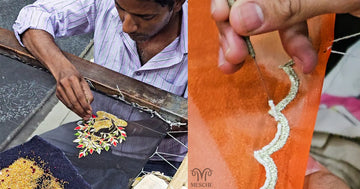Introduction: The Lost Elegance of Handwoven Sarees
There was a time when every saree draped by an Indian woman told a story—woven with threads of tradition, artistry, and cultural pride. From the intricate Zardozi work of Mughal India to the delicate Jamdani of Bengal, handwoven sarees were once the heart of Indian fashion. But with the rise of mass-produced textiles, this art faded into the background.
Yet, in recent years, the demand for handwoven sarees has surged once again. Why is this forgotten craft making a grand comeback? Let’s explore the reasons behind this revival and what it means for fashion, artisans, and the future of sustainable luxury.
The Decline of Handwoven Sarees: What Went Wrong?
1. Rise of Machine-Made Fabrics
With industrialization, machine-woven sarees flooded the market, offering cheaper and faster alternatives. This shift led to a decline in demand for traditional handwoven fabrics.
2. Loss of Skilled Artisans
Many weavers, unable to compete with mass production, abandoned their ancestral craft. Generations of weaving knowledge risked being lost forever.
3. Changing Fashion Trends
As Western wear became more popular in India, sarees took a backseat, especially among younger generations who saw them as outdated or cumbersome.
Why Handwoven Sarees Are Making a Comeback
1. The Revival of Slow Fashion
Consumers today are moving away from fast fashion and embracing handcrafted, sustainable clothing. Handwoven sarees, which take days (sometimes months) to create, fit perfectly into this philosophy. Unlike machine-made alternatives, they are made with precision, patience, and love—qualities that modern buyers increasingly appreciate.
2. A Statement of Cultural Pride
From Bollywood celebrities to global fashion influencers, sarees have reclaimed the spotlight. Designers are reinventing traditional weaves with modern silhouettes, making them desirable for all age groups.
3. A Boost in Artisan Recognition
Social media and ethical fashion movements have brought attention to the weavers behind these masterpieces. Consumers today want to know where their clothes come from and are choosing brands that support traditional craftsmanship.
4. The Luxury Factor
Handwoven sarees are not just garments—they are heirlooms. Each weave tells a story, making it a timeless addition to any wardrobe. Luxury designers are incorporating handloom fabrics into high-fashion collections, reinforcing their exclusivity.
5. Support from Government & Brands Like Mesche
Various government initiatives and brands like Mesche are helping to revive handloom weaving by working directly with artisans, ensuring fair wages, and promoting handcrafted sarees in the global market.
Why Handwoven Sarees Are More Expensive Than Machine-Made Sarees
It’s common for buyers to wonder why handwoven sarees are priced higher than their machine-made counterparts. Here’s what makes them worth the investment:
1. Time-Intensive Craftsmanship
Unlike machine-made sarees, which can be produced in bulk within hours, a handwoven saree can take weeks or even months to complete. Each piece is carefully crafted by skilled artisans, ensuring unmatched quality and detailing.
2. Skilled Artisans and Traditional Techniques
Handwoven sarees are not just stitched; they are woven thread by thread on a traditional loom. This requires immense skill, patience, and years of experience. Artisans often pass down their knowledge through generations, making every saree a piece of cultural heritage.
3. High-Quality Materials
Handloom sarees often use premium natural fibers like pure silk, cotton, and fine wool, which are more expensive than synthetic materials used in mass-produced textiles. The dyes used are also traditionally organic, making them more sustainable but costlier.
4. Uniqueness & Exclusivity
No two handwoven sarees are exactly alike. The uniqueness of imperfections, human touch, and artisanal weaving makes them exclusive, unlike machine-made sarees that are mass-produced with identical patterns.
5. Sustainability & Fair Wages
When you buy a handwoven saree, you’re supporting ethical fashion. Machine-made sarees rely on industrial processes that exploit labor and damage the environment. On the other hand, handwoven sarees support local artisans and pay them fair wages for their skilled labor.
6. Long-Lasting Durability
Handwoven sarees often outlast machine-made ones. The craftsmanship ensures that with proper care, they can be passed down for generations—making them a better long-term investment.
How to Embrace the Handwoven Saree Renaissance
Invest in Authentic Handwoven Sarees
Look for brands that source directly from artisans. Every purchase supports a weaver’s livelihood and keeps the craft alive.
Style Handwoven Sarees in Modern Ways
Pair them with crop tops, jackets, or belts for a contemporary look. Handloom doesn’t mean old-fashioned—it means timeless!
Spread Awareness
Talk about the beauty of handwoven fabrics, share stories of artisans, and encourage others to choose handmade over machine-made.
Final Thoughts: A Legacy Worth Reviving
Handwoven sarees are more than just fabric—they are a piece of history, an art form, and a symbol of India’s rich cultural heritage. Their revival isn’t just about fashion; it’s about preserving a legacy, supporting artisans, and making sustainable choices.
At Mesche, we celebrate this revival by blending intricate handwoven artistry with bold modern flair. Our sarees are crafted to help you feel both elegant and empowered.
Shop Handwoven Sarees from Mesche
Embrace the beauty of handcrafted elegance with Mesche’s exclusive collection of Dastkaari Collection sarees. Each piece is a testament to skilled artistry, tradition, and timeless style.
🛍 Explore Our Collection: Dastkaari Collection
🌿 Why Choose Mesche? Ethical, sustainable, and crafted with love.
Stay ahead in fashion while supporting artisans—shop now!

